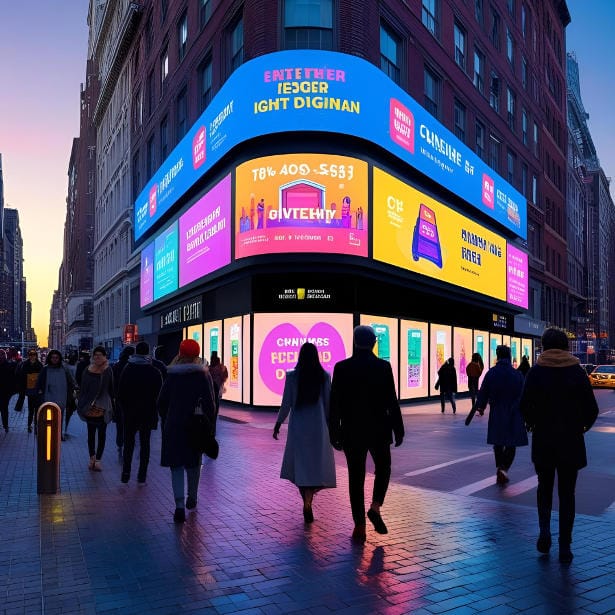The present digital and rapidly moving business environment makes it harder than ever for businesses to attract new customers. A business must discover unique methods for attracting attention through meaningful audience engagement. Outdoor digital signage or digital signage exterior serves as a strong communication tool for businesses to reach their customer base. An outdoor digital signage system placed in streets and retail locations, or suburban areas will create a noticeable impact by attracting viewers to receive real-time specific messages.
This article provides a complete roadmap that will guide you through the entire process of choosing optimal digital signage outdoor solutions for your business operations.

Understanding Digital Signage Exterior
Electronic displays that convey information and advertisements outdoors to the public constitute digital signage exterior systems. The systems function to endure different environmental conditions, which include harsh weather conditions and temperature changes alongside exposure to direct sunlight while presenting clean and distinct content. Such displays enable businesses to engage their viewers effectively when located in public zones through brand promotions, public messaging, and promotional deals.
The main distinction between outdoor digital signage and indoor signage emerges from the requirements to endure harsh outdoor elements during installation. To succeed in outdoor environments, displays need resistance against all-weather elements, improved visibility, distance management abilities, and exceptional content quality.
Key Considerations for Exterior Digital Signage Systems
Multiple essential elements must be evaluated when choosing exterior digital signage systems to achieve successful outdoor operation. The features described below determine how effective your outdoor signage becomes.
Environmental Ruggedness
The selection of outdoor digital signage depends heavily on how well the system withstands different environmental factors. Outdoor signage requires specific construction elements that should include:
• Extreme Temperatures: Digital displays must perform under extreme temperature fluctuations between hot and cold climatic conditions.
• Rain, Snow, and Wind: The display must have protective shielding that protects against moisture and wind damage in addition to rain and snow.
• Dust and Dirt: The systems must have proper sealing methods to prevent dust and dirt from entering because these environmental elements can block visibility.
A durable enclosure, together with an efficient thermal management system, should be features of your choice when purchasing signage for extreme outdoor environments. Sustainable performance alongside long-term durability comes from choosing top-quality weatherproof displays.
Screen Visibility
Your digital signage requires maximum external visibility as its main priority. Outdoor environments create multiple obstacles for clear display viewing because of direct sunlight exposure and reflections together with shifting light conditions. The following features should be considered to improve overall visibility:
• High-Brightness Screens: The screen should be at least 2000 nits bright because it will allow users to watch videos in direct sunlight.
• Anti-glare Coatings: These make it easier to read the output of the screen by reducing glare in the screen.
• Appropriate Screen Sizes: Large screens with higher resolution enable the content to be viewed from a distance, and the content is more enjoyable to the passer-by.
It will be possible to reach a high level of the screens with anti-glare protection that will make the display easily readable and unobtrusive in any conditions.
Content Adaptation
Another advantage of digital signage exterior systems is that the content can be changed depending on the conditions of the outside environment. There are several features that can be incorporated to make content adaptable, and these features are useful in increasing the impact of the signage:
• Automatic Brightness Control: This is a feature that enables the screen to adjust to the surrounding light conditions in an attempt to be bright during the day and not be too bright at night.
• Remote Content Management: Since a content management system (CMS) will be set up, it will offer you the opportunity to make changes to your content as and when necessary, from any other location.
With the help of adaptive content features, you can ensure that your digital signage stays fresh and timely in front of the viewer.
Connectivity and Network Infrastructure
This is because in order for an outdoor digital signage system to be efficient, it has to have proper connectivity for remote monitoring and updating of the signs. When selecting your signage, consider:
• Wired Networks: These are fixed and secure for transferring content updates and for controlling the systems from the other station.
• Wireless Networks: This is perfect for places with fewer structures to support the networks since they are easy to install and more flexible.
Check that your signage system’s network capacity is adequate for the type of content you are using, updating the content and synchronizing between different sites if required.
Power Supply and Energy Efficiency
One of the key considerations to be addressed when installing outdoor digital signages is the power supply, as the system must be on all the time. However, the cost of power is one of the continuous costs that may be incurred in the course of running the business. When buying these displays, ensure that they are energy efficient and should have the following features.
• Automatic Power-Saving Modes: Those modes are effective in cutting down the power usage during the hours when energy is not expensive.
• Solar-Powered Options: There is nothing better than solar signs, especially for areas that cannot have access to electricity or have limited access to electricity.
When deciding on the best solutions, it is possible to choose those that will allow the signage to work continually without incurring high expenses and contributing to the environmental cause.
Security and Protection
Another disadvantage of outdoor signage is that it can be exposed to vandalism, theft, or any other security issues. To protect your investment:
• Tamper-Proof Enclosures: Enclosures with anti-tamper designs and security locks also assist in reducing cases of people accessing the display and its components.
• Surveillance Systems: It is possible to put up security cameras or any other security measures around the signage to discourage theft and vandalism.
Selecting secure enclosures also helps you protect your signs from vandals and environmental conditions that may render them non-functional or even destroy them.

Types of Digital Signage Outdoor Displays
The market provides different types of outdoor digital signage displays that suit different needs depending on the environment.
LED Displays
The market favors LED displays for outdoor signage because these displays offer outstanding brightness, vibrant visuals, and extremely long operational life. The displays demonstrate exceptional durability since they can function properly under all weather conditions, including harsh outdoor conditions.
LCD Screens
The image quality of LCD screens remains exceptional because they deliver accurate colors during display. Protective enclosures are necessary to guard LCD screens because they need defense against environmental conditions such as rain, wind, and dust. The weather conditions in locations with limited harsh weather exposure make LCD screens a suitable choice.
Interactive Kiosks
Interactive kiosks have become popular choices for installing digital displays outside. These interfaces enable direct user interaction so clients can locate their way to browse the menu and participate in promotional activities. Kiosks function as excellent tools to enhance customer interactions while delivering interactive content.
Weatherproof Signage
Signage-made weatherproof functions effectively under all types of weather conditions. The systems adopt resilient constructions coupled with protective housing that defend against environmental threats and enable unbroken operation throughout all seasons.
Solar-Powered Options
Using solar power makes digital signage both ecologically beneficial and cost-efficient for operation. These displays function through solar power, which makes them suitable for locations without conventional power grid access.

Choosing the Right Content Management System (CMS)
The operation of your outdoor digital signage displays heavily depends on using a reliable Content Management System (CMS). Your selection of a CMS should include features such as:
• Remote Access: Remote management through remote access enables distance-based content updates so you can control everything from any location.
• Real-Time Updates: The CMS system you select must provide continuous real-time content capability to maintain relevant current material.
• User-Friendly Interface: Select a CMS that provides an interface that users with different technical abilities can easily navigate.
Three common CMS solutions available for outdoor signage management systems are NoviSign ScreenCloud and Samsung MagicINFO, which provide robust control systems.
Start Your 14-Day Free Trial with Nento Corp
Your outdoor digital signage setup stands at a point where you can achieve significant improvements. Experience our digital signage management solutions by starting the 14-day no-cost trial at Nento Corp. Our company’s complete platform will enable your business to achieve ground-breaking visibility and engagement results.
FAQs
What should I consider when choosing an outdoor digital sign?
Users need to evaluate how the display handles tough environments, visibility needs, content flexibility, power reliability, security measures, and remote management capabilities through the right CMS.
How do I update content on outdoor digital signage?
Through a solid CMS, you gain the ability to modify content from any location, which helps keep your messaging current and appropriate.
Can outdoor digital signs work in all weather conditions?
Displays that combine weatherproof capabilities together with essential protective features become operational in any weather condition.
What types of outdoor digital signage are available?
The most frequently used forms of outdoor digital signage include LED displays with LCD screens as well as interactive kiosks combined with weatherproof signage and solar-powered options.





